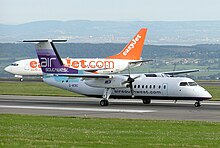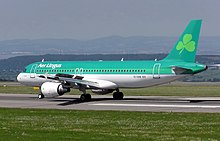Bristol Airport
Template:Airport title
Template:Airport image Template:Airport infobox Template:Runway title Template:Runway
Template:Airport end frame Bristol International Airport (IATA: BRS, ICAO: EGGD) is the commercial airport serving the city of Bristol in England, and the surrounding area.
Bristol International Airport has a CAA Public Use Aerodrome Licence (Number P432) that allows flights for the public transport of passengers and for flying instruction.
History
In 1927 a group of local businessmen raised £6,000 through public subscription to inaugurate a flying club at Filton Aerodrome. By 1929 the club had become a success and it was decided that a farm located in Whitchurch near Bristol would be developed into an airport. In 1930, The Prince George, son of King George V opened Bristol Airport — becoming the third such airport in the United Kingdom. Passenger numbers grew from 935 in 1930 to over 4,000 in 1939.
During World War II, Bristol Airport was the only civil airport still in operation in the UK, meaning all flights usually bound for London were terminated in Bristol. The newly formed British Overseas Airways Corporation were dispersed to Whitchurch from Croydon and Gatwick Airports. They operated on routes to Lisbon, Portugal and to some other neutral nations. Whitchurch continued to be used after WW2, but the introduction of heavier post-war airliners made a runway extension highly desirable. However, this was very difficult, because of the proximity of the surrounding housing estates.
Consequently, a decision was taken in 1955 to develop a new airport at Lulsgate Bottom Airfield near Redhill, from a former wartime RAF station, which had been operating in peacetime as a glider station. The new airport was called Bristol Lulsgate Airport and was opened in 1957 by Princess Marina, Duchess of Kent. In its first year 33,000 people used the airport. In 1963 the runway was lengthened and in 1965 extensions were made to the terminal — all due to rapid expansion. In 1968 a new 5,000 square foot (460 m²) building was constructed — again as the airport expanded. In 1974 the airline "Court Line" collapsed, causing a fall in passenger numbers.
By 1980 17 charter airlines were operating from the airport. Additions in 1984 included an international departure lounge, duty free shops, a 24-hour air-side bar, an arrivals concourse, and a short-term car park. On 1 April 1987 all employees were transferred from Bristol City Council to Bristol Airport plc. The operation and net assets of Bristol Airport were transferred from the City of Bristol and the company commenced trading. Over the next few years business boomed with over 100,000 passengers each month in the summer of 1988. The particular growth of the airport at this time is directly attributed to the work and actions of the managing director Les Wilson who was sadly lost in a car crash in November 1995.
In 1996 Bristol Airport was sold by Bristol City Council. In March 1997 its name was changed from Bristol Airport to Bristol International Airport. In December 1997 51% of the airport was sold to FirstGroup plc, while the remaining 49% stayed with Bristol City Council. A new terminal building was built in April 1999 and opened in March 2000. In 2000, passenger numbers exceeded two million for the first time.
 |
 |
 |
 |
2001 onwards
The airport was bought by Macquarie Bank and Cintra in January 2001 for £198m. Passenger numbers passed through 3 million in 2002, largely due to the arrival of the low-cost carrier Go Fly. Continued expansion by easyJet led to another increase in passengers — to 3.8 million. In May 2005, Continental Airlines introduced direct flights from Bristol to Newark with Boeing 757-200 aircraft.
Proposed expansion
In 2006 the airport handled more than 84,000 aircraft movements and 5.75 million passengers. [1] Controversy surrounds the proposed expansion of the airport to allow it to handle even more. A coalition to fight the expansion, known as Stop Bristol Airport Expansion has been formed by Bristol Friends of the Earth, Campaign to Protect Rural England (CPRE) and other groups and individuals in North Somerset, Bristol and BANES.
2007 resurfacing controversy
On 5 January 2007 many flights were cancelled or diverted, including all easyJet and XL Airways flights. This was due to braking action on the runway not being the required standard for safe stopping in wet conditions. Virtually all of the operations were moved to Cardiff International Airport by these two airlines. easyJet moved 60% of its operations to Cardiff during this weekend of disruption, the first time easyJet had ever need to undertake such a move. Because of the disruption, staff were sent to Cardiff from Bristol to help with the workload.
The problem arose from a new £17 million asphalt runway surface not being sufficiently grooved to allow water run off. Although the new runway was given Civil Aviation Authority clearance on 4 January, 2007, there had been a number of incidents over the previous four weeks, with aircraft unable to stop without running over the operating limits of the runway.
A British Airways spokeswoman said it would not operate flights if the runway moisture levels were above a certain level, and subsequently the airline cancelled several of their flights. [2]
On Sunday 7 January, following further cancellations, Bristol Airport management made the decision to close the runway from 14:30 for work to resolve the problem. The runway remained closed during Monday 8 January. [3]
Airlines and destinations
Scheduled Services
The following is a list of regular scheduled airlines and their destinations. Holiday or charter flights are not listed.
- Aer Arann (Cork, Galway [Begins June 25, 2007], Nantes)
- Air France (Paris-Charles de Gaulle [Begins June 11, 2007])
- Air Malta (Luqa)
- Air Southwest (Jersey, Leeds/Bradford, Manchester, Newquay, Plymouth)
- Aurigny Air Services (Guernsey)
- British Airways
- operated by GB Airways (Tenerife-South)
- Brussels Airlines (Brussels)
- Continental Airlines (Newark)
- Eastern Airways (Aberdeen, Isle of Man)
- easyJet (Alicante, Amsterdam, Barcelona, Belfast-International, Berlin-Schönefeld, Bordeaux, Edinburgh, Faro, Geneva, Glasgow-International, Grenoble, Ibiza, Inverness, Kraków, La Rochelle, Madrid, Mahon, Marseille, Malaga, Milan-Malpensa, Murcia, Newcastle, Nice, Palma de Mallorca, Paris-Charles de Gaulle, Pisa, Prague, Rijeka, Rome-Ciampino, Toulouse, Valencia, Venice, Warsaw [Begins October 2, 2007])
- Flybe (Jersey)
- KLM
- KLM Cityhopper (Amsterdam)
- OLT (Ostfriesische Lufttransport) (Bremen, Hamburg)
- Ryanair (Bratislava [starts 8 November 2007], Budapest [starts 7 November 2007], Derry [starts 7 November 2007], Dinard [starts 8 November 2007], Dublin, Girona, Katowice [starts 10 November 2007], Knock [starts 7 November 2007], Milan [starts 7 November 2007], Porto [starts 7 November 2007], Poznañ [starts 8 November 2007], Riga [starts 7 November 2007], Rzeszów [starts 8 November 2007], Salzburg [starts 19 December 2007], Shannon, Wroclaw [starts 7 November 2007])
- Scandinavian Airlines System (Stockholm-Arlanda [Begins June, 2007])
- Skybus (Isles of Scilly)
Charter services
The following is a partial list of charter airlines and their destinations. As charter flights are mainly intended for holiday traffic they are seasonal and may not operate continuously through the year.
- BH Air (Bourgas, Varna, Plovdiv)
- First Choice Airways (Alicante, Banjul, Faro, Grenoble, Orlando-Sanford)
- XL Airways (Tenerife-South)
General Aviation
Bristol Airport is a general aviation (GA) centre. In 2006 the GA terminal was relocated from the north side next to the control tower, to a purpose-built facility on the south east corner of the field. There are 2 GA organisations based at Bristol. All GA handling for visiting aircraft is managed by Bristol Flying Centre, who also provide pilot training and engineering services. Bristol & Wessex Aeroplane Club, who are based next to the Bristol Flying Centre, provide pilot training on both fixed wing aircraft and helicopters.
See also
References
- ^ "Airports Data". Liaison Group of UK Airport Consultative Committees. Retrieved 2007-05-11.
- ^ "Flights cancelled in safety row". BBC News. 5 January 2007. Retrieved 2007-05-11.
{{cite web}}: Check date values in:|date=(help) - ^ "Safety row disrupts ten airlines". BBC News. 6 January 2007. Retrieved 2007-05-11.
{{cite web}}: Check date values in:|date=(help)
External links
- Bristol International Airport official website
- Bristol Flying Center - flight training and GA handling.
- Bristol & Wessex Aeroplane Club
- Stop Bristol Airport Expansion Homepage
